The European corn borer (Ostrinia nubilalis) is economically the main pest in the European corn growing. Without direct control it can cause serious crop losses of more than 30 dt/ha. The economic threshold with grain corn is at 25-30 % infested plants, with silage corn at 35-45 %.
Geographic range:
Introduced to Germany at the beginning of the 19th century, in the meantime it occurs in all growing areas. Until about 15 years ago it only caused damage in the former core areas. This infested areas primarily comprise the Rhine Graben, the Lake Constance area, Southern Hesse, parts of the Palatinate and the greater Stuttgart area. Today, the corn borer can be found in the entire Southern German region, also in altitudes of up to 700 m. And it is continuing to spread. To the north, it has reached via the Cologne Basin the growing areas of Lower Saxony. In the east it causes serious damage in Thuringia, Saxony-Anhalt, Saxony and parts of Brandenburg. Already in 2006, the first moths were caught at the North Sea.
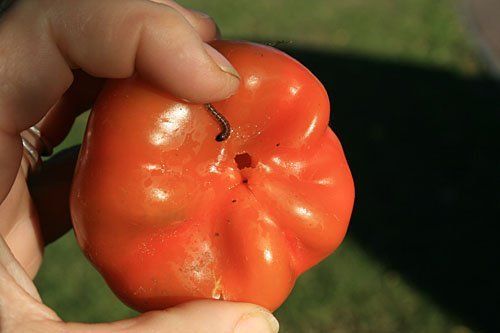
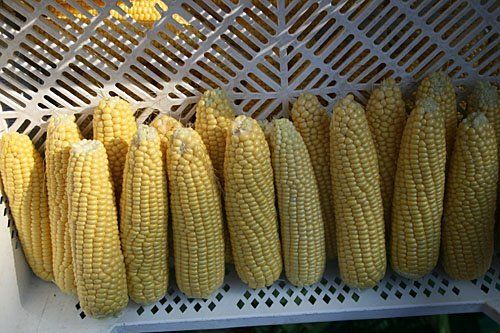

Also in the neighboring countries Poland, Czech Republic, Slovakia, Hungary and Austria in part significant damage is registered. In Switzerland, Italy and France it regionally even occurs in two generations.
The European corn borer is polyphagous, i.e., besides corn, it develops in many other crops like pepper, tomato, hop, beans, stinging nettle, Amaranth-species etc. Its enormous adaptability to different crops and climatic conditions is the reason for the continuous spreading even into rather inhospitable regions.
The pest:
The larvae hibernate in the corn stubbles. Depending on the weather, pupation starts from mid/end May and from the beginning of June the first moths fly. The moth flight begins with the flight of the males, the females follow in a span of 3-5 days. The nocturnal moths hide during the day in the corn, but often also in adjacent crops. At the beginning of dusk they become active and the females lay the eggs in imbricated clusters of up to 40 eggs on the undersides of the leaves of the corn plants.
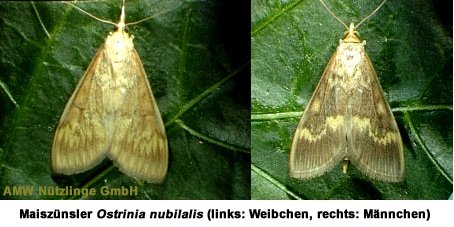
During the approximate lifetime of 10 days, a female lays up to 1000 eggs. It prefers high and lush corn crops for oviposition. The hatching larvae first eat the blossoms and uppermost leaves of the plants, then they descend and finally bore themselves into the corn plant. Before boring, the larvae also spread by the wind, by letting themselves be carried further on hanging from a gossamer. Like that, they can cover distances of up to 4 m. From the 3rd larval stage, the boring into the stalk and cob takes place.
The larva of the European corn borer cannot chew through the hard plant nodes, therefore it leaves the stalk and bores itself again into it or changes the plant. At the end of the vegetation period, the larva has arrived at the stalk base where it hibernates. The larva hibernates in diapause, a genetically determined dormancy that is initiated by temperature and light. Of course, the amount of hibernating larvae is reduced by fungal infection or feeding by birds.
The bivoltine European corn borer strain
In Germany mainly an (univoltine) generation of the European corn borer flies, but since 2003 regionally a second generation that has established in Southern Baden can be observed. In southern Europe regularly 2-3 generations occur. In 2015, a strong flight of the bivoltine European corn borer strain was observed again, partially also pupae of a 3rd generation have been found. Also on the reference site in northern Baden we found a pupa that might suggest the beginning occurrence of the bivoltine strain.
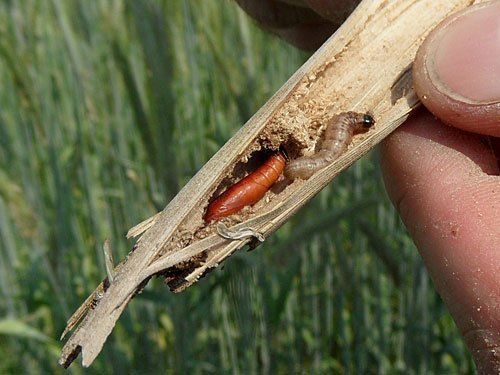
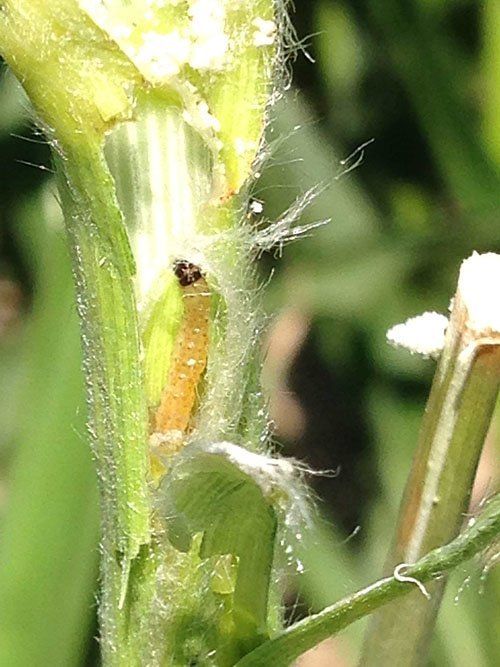

Besides the additional threat to corn growing by the corn rootworm, another larva that can regionally damage the corn significantly occurs relatively unnoticed: the cotton bollworm Helicoverpa armigera. A pest that is immigrating from the Mediterranean area, that like the European corn borer infests a large range of different plants and damages them substantially by feeding. Helicoverpa too has regionally become a problem in 2015, the big larvae caused damage in vegetables and tomatoes, also in sweet corn larvae could be observed.
The appearance of the European corn borer is determined by the color of the wings. The moths have a total length of 20-30 mm. The colors and markings of the moths may differ.
Female moth:
With a size of 25-30 mm they are longer than the males. The forewings are light to ocher yellow with three wavy bands. The grey-brown hindwings are marked by two dark crossbands with a light border. A clear differentiator is the thick abdomen of the females.
Male moth:
The forewings of the male are cinnamon with yellow wavy crossbands running over the wings. The bright spot in the center is typical. The hindwings are grey-brown with a light border.
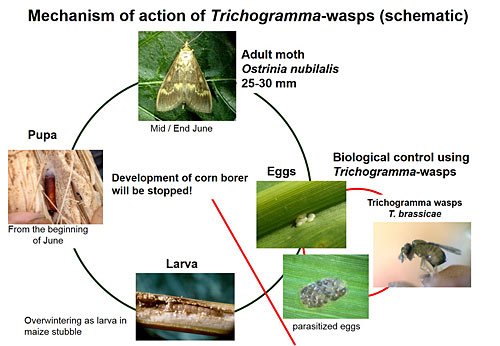
The lifetime of the moths is strongly influenced by the weather conditions, on average the moths live between 4 and 10 days. With high humidity longer than with lower humidity. Females live longer than males. The sex ratio is approx. 50:50.
Dry, warm weather conditions usually lead to a short and strong flight of the moths. In wet and cool summers the flight drags on over a much longer period. The moths become active at night temperatures above 11°C, the main activity is at 18-20°C. The moths use thermal and winds and are able to cover long distances of up to 20 km per night.
Decisive for the later infestation is the weather during oviposition. Under optimal conditions a female can lay up to 1000 eggs. The females fly along the rows and prefer strong plants for the oviposition. A large part of the hatching larvae already dies in the first development stages. If weather conditions are optimal in this period, the share of surviving larvae is much higher.
Secondary damage caused by the European corn borer
The feeding of the larva damages the pathways inside the corn plant; this leads to a undersupply that can result in a weak formation of cobs and a low plant height. In years with a strong cob infestation by larvae, also a infection of the cobs with several Fusarium fungi or smut occur. In 2014, the resulting mycotoxins led to serious problems in marketing.

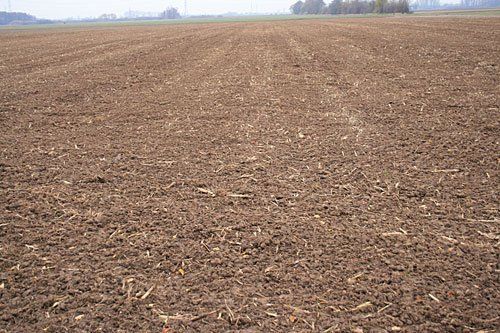

The indirect, mechanical control of the larvae:
The control of the European corn borer is one of the most important measures to secure a successful harvest. When harvesting, about 70 % of the larvae are below the 2nd node. Thus, in addition to the direct control also indirect control measures as chaffing the stubbles and a clean and deep ploughing are important, in order to significantly reduce the share of surviving larvae of the European corn borer. There must be no entire stalk remains on the soil surface in which the larvae hibernate.
Another important side effect of treating the corn stubbles is an improved soil hygiene. The infection of subsequent crops like wheat or corn with damaging fungi or viruses is reduced.
Where ploughing is not possible, the well chopped plant remains from grain corn and silage corn should be flatly incorporated in order to accelerate the rotting of the stubbles. Liming with carbonic magnesium-lime and nitrogen intensifies the straw rotting. The additional administration of lime-nitrogen in spring stimulates the rotting process and has an insecticidal effect on the soil pests.
The strip-till system has labour-economic and ecological advantages. But the non-plough tillage of corn benefits the advance of the corn borer, as too many plant parts remaining on the surface and not being chopped offer hibernation possibilities for the larvae.
An extensive stubble working, that at best includes the whole area, is especially important. Individual, not worked surfaces serve the next year as sources of infection for all surrounding fields!
An example for the population development of the European corn borer:
Assumption:
- 1 female lays approx. 30 clusters from which 5 larvae each develop.
- 1 x 30 x 5 = 150 larvae (= 75 females)
- The population increases by the factor 75!
Just in order to keep the population at the same level, 74 of the 75 females would have to die.
This corresponds to a necessary reduction of 98.7%!
Therefore, in addition to the direct control with Trichogramma (or insecticides) also the indirect control measures have to take place on a regular basis.

